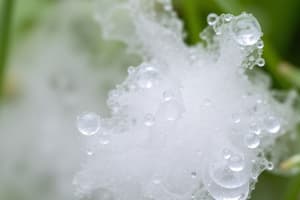Podcast
Questions and Answers
What is the essential requirement for cloud formation regarding temperature?
What is the essential requirement for cloud formation regarding temperature?
- Air must reach the dew point temperature (correct)
- Air must be in a vacuum
- Air must have low pressure
- Air must be at surface temperature
Clouds always bring rain.
Clouds always bring rain.
False (B)
What are cloud condensation nuclei?
What are cloud condensation nuclei?
Small particles in the atmosphere that provide a surface for water vapor to condense upon.
The temperature at which condensation occurs is known as the ______.
The temperature at which condensation occurs is known as the ______.
Match the following cloud types with their characteristics:
Match the following cloud types with their characteristics:
Which of the following processes can cool air to reach dew point temperature?
Which of the following processes can cool air to reach dew point temperature?
Lapse rates refer to the increase in temperature with height.
Lapse rates refer to the increase in temperature with height.
What happens to an air parcel when its density matches that of the surrounding air?
What happens to an air parcel when its density matches that of the surrounding air?
Which of the following contributes to the formation of turbulence?
Which of the following contributes to the formation of turbulence?
Air sinks toward the surface in low pressure areas.
Air sinks toward the surface in low pressure areas.
What happens to air as it rises in low pressure systems?
What happens to air as it rises in low pressure systems?
The primary force that sets air in motion is the ___.
The primary force that sets air in motion is the ___.
Match the types of clouds with their characteristics:
Match the types of clouds with their characteristics:
What is the typical decline of temperature in the Environmental Lapse Rate (ELR) per 1000 meters?
What is the typical decline of temperature in the Environmental Lapse Rate (ELR) per 1000 meters?
The Dry Adiabatic Lapse Rate (DALR) applies when the relative humidity is greater than 100%.
The Dry Adiabatic Lapse Rate (DALR) applies when the relative humidity is greater than 100%.
What happens to the temperature of an air parcel as it rises in the atmosphere?
What happens to the temperature of an air parcel as it rises in the atmosphere?
The _____ Adiabatic Lapse Rate (SALR) considers the release of latent heat when water condenses.
The _____ Adiabatic Lapse Rate (SALR) considers the release of latent heat when water condenses.
Match the following lapse rates with their characteristics:
Match the following lapse rates with their characteristics:
Which of the following factors does NOT influence the lapse rate?
Which of the following factors does NOT influence the lapse rate?
An unstable atmosphere forms when an air parcel cools faster than the surrounding air.
An unstable atmosphere forms when an air parcel cools faster than the surrounding air.
What are the two types of convection mentioned?
What are the two types of convection mentioned?
What happens to an air parcel that cools more rapidly than the Environmental Lapse Rate?
What happens to an air parcel that cools more rapidly than the Environmental Lapse Rate?
A stable atmosphere is characterized by significant up and down circulations.
A stable atmosphere is characterized by significant up and down circulations.
What usually causes air to return to its initial location after being displaced?
What usually causes air to return to its initial location after being displaced?
In summer, the sun heats the surface and creates an unstable atmosphere resulting in __________.
In summer, the sun heats the surface and creates an unstable atmosphere resulting in __________.
What is absolutely stable air characterized by?
What is absolutely stable air characterized by?
Match the following terms with their meanings:
Match the following terms with their meanings:
Conditional instability means that saturated air is stable while dry air is unstable.
Conditional instability means that saturated air is stable while dry air is unstable.
What phenomenon can occur when water vapor reaches its saturation point under conditional instability?
What phenomenon can occur when water vapor reaches its saturation point under conditional instability?
Flashcards are hidden until you start studying
Study Notes
Cloud Formation
-
Clouds are formed when air cools to its dew point temperature, causing water vapor to condense.
-
The dew point temperature is the temperature at which air becomes saturated with water vapor.
- Higher humidity leads to a higher dew point temperature.
-
Cooling of air can occur through:
- Thermal updrafts: Warm air rises, expands, and cools.
- Physical barriers: Air is forced to rise over mountains or other barriers.
- Turbulence: Friction between the air and the ground creates turbulent eddies, leading to mixing and cooling.
-
Cloud condensation nuclei are small particles in the atmosphere that provide a surface for water vapor to condense on.
- These particles can be derived from natural sources, such as dust, pollen, and sea salt.
Lapse Rates
-
Lapse rate refers to the rate at which temperature decreases with increasing altitude.
- Environmental lapse rate (ELR) is the actual decrease in temperature with height, influenced by local air conditions and topography.
-
Dry adiabatic lapse rate (DALR) is the theoretical rate at which dry air cools as it rises, approximately 9.8°C per 1000m.
- This applies when air is unsaturated with water vapor.
-
Saturated adiabatic lapse rate (SALR) accounts for the release of latent heat when water vapor condenses, leading to a slower rate of cooling.
- The SALR varies but is typically around 5.4°C per 1000m.
Atmospheric Stability
-
Unstable atmosphere:
- Air parcels cool slower than the surrounding air and continue to rise.
- Increased lapse rates lead to instability, such as during summer or when cold air moves over warm air.
- Free convection and thunderstorms can occur.
-
Stable atmosphere:
- Air parcels cool faster than the surrounding air and return to their initial location.
- Little convection occurs except for forced convection due to topography or weather fronts.
Cloud Types
-
Cumuliform clouds: Formed through convection, these are puffy, cotton-like clouds.
- They can develop into cumulonimbus clouds (thunderstorms).
-
Stratiform clouds: Formed by slower, more widespread ascent.
- These are layered clouds that often cover large areas.
Other Factors
-
Turbulence: Friction with obstacles and wind shear can create turbulent eddies, lifting air and contributing to cloud formation.
-
Air Motion:
- High pressure: Air sinks, preventing cloud formation.
- Low pressure: Air rises, leading to cooling and cloud formation.
- Pressure gradients drive air movement, influencing cloud formation.
-
Cloud Condensation Nuclei:
- Aerosols in the atmosphere provide surfaces for condensation.
Studying That Suits You
Use AI to generate personalized quizzes and flashcards to suit your learning preferences.



